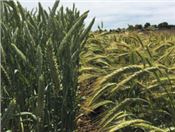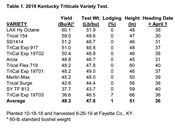Triticale, Cross Of Wheat, Rye, Offers Growers Choice In Winter Crops

BILL BRUENING
LEXINGTON, KY.
Triticale is a winter small grain crop species that was developed in the late 19th century by a plant breeder’s cross between wheat (Triticum) and rye (Secale). The breeder’s goal was to utilize the grain quality, productivity and disease resistance of wheat with the winter hardiness, disease resistance and vigor of rye. Over the past few decades, emphasis on varietal development has resulted in improved grain yield potential, disease and lodging resistance, as well as forage production potential. Triticale grain is utilized for animal feed, human foods, specialty brewing & distillation and as a cover crop.
Triticale is self-pollinating (similar to wheat), which is different from rye that is cross-pollinated and susceptible to pollination issues in production. Its fall and spring growth rate, height and lodging potential is usually greater than wheat but less than rye. It has excellent cover crop potential, due to its rapid growth rate and it being easier to control than volunteer rye if the crop re-seeds itself. Grain test weight, baking and milling qualities are less than wheat. The protein content has been reported to be higher than wheat, but the glutenin fraction is less. It can be used to produce quality forage up to the boot stage – thereafter quality declines rapidly with reproductive growth.
Triticale is planted for grain production at the same time and seeding rate as wheat. Management practices are the same for both crops. Nitrogen applications should not exceed the recommended rates for wheat (due to increased lodging potential). In general, triticale matures a few days after wheat.
The University of Kentucky Small Grain Variety Testing Program annually tests Triticale varieties for grain yield potential and other agronomic characteristics. Results are available online at http://www.uky.edu/Ag/wheatvarietytest/ . Table 1 from the 2019 University if Kentucky test show differences in grain yield potential, test weight, lodging, height and heading date among 12 triticale varieties. ∆
BILL BRUENING: Research Specialist, University of Kentucky
